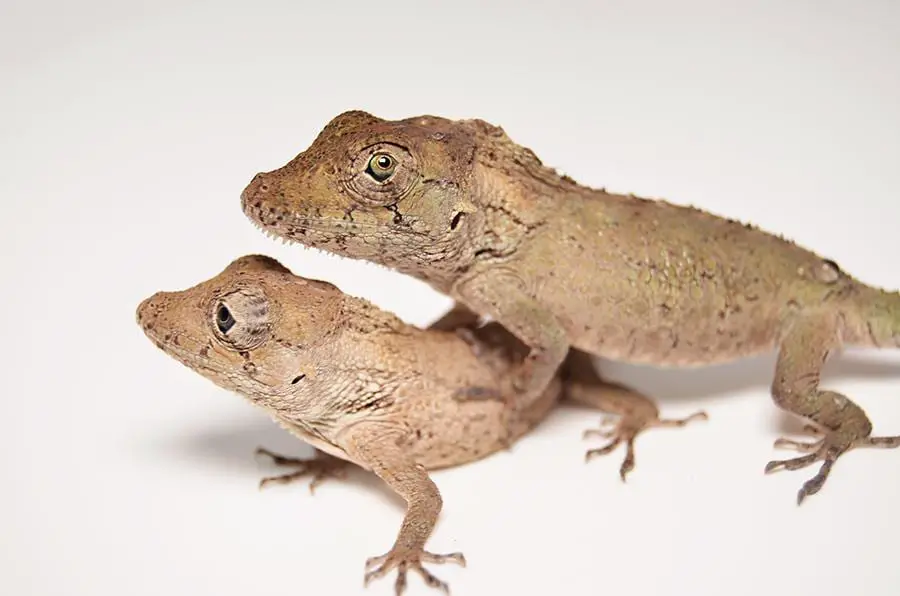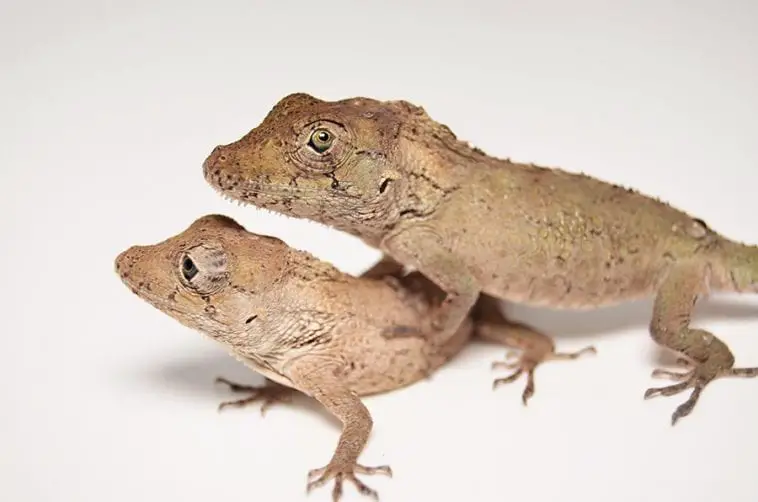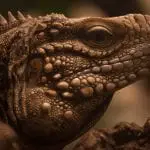Scientific Facts
| Common Name: | Cuban False Chameleon |
| Scientific Name: | Anolis Barbatus |
| Life Span: | Less than 10 years |
| Length: | 7 to 12 inches |
| Clutch Size: | 1 every 30 days |
| Habitat: | Broadleaf Forests, Closed Canopies |
| Country of Origin: | Cuba |
Physical Description

If you are searching for an easy-to-care, exotic pet to add to your collection, there is no doubt that Cuban False Chameleons are good candidates. They are among the most unique looking lizards found in the Caribbean. They have a huge, bony casque at the end of their skull, making them look like aliens instead of animals. They also have a row of very flexible barbell-like scales found beneath their chin, and along the edges of their dewlap.
Cuban False Chameleons are actually reptiles, given the name because they are related closely to anoles, and for their chameleon-like behavior. They exhibit slow movements, as well as independent eye movements. Just like real chameleons, they also have really long tongues. One feature that makes them unique is the fact that they predominantly feed on insects and snails. As suggested by their name, they are only found in Cuba.
Despite being obvious as a large lizard, with a size that is longer than 7 inches when measured from the snout to vent for males, and less than 7 inches in length for females, most lizards are usually found on perches with small-diameter sizes. Their bodies are laterally compressed, with short tails and short limbs. These features of their body make it easy for them to move along narrow twigs.
Origin
Before being the Cuban False Chameleons that we know today, these animals used to be a part of a genus with five recognized species – Chamaeleolis Agueroi, Chamaeleolis Barbatus, Chamaeleolis Chamaeleonides, Chamaeleolis Guamuhaya, and Chamaeleolis Porcus. All of these subspecies are considered native to Cuba.
However, the entire group was classified under the Anolis genus, while Chamaeleolis is now being regarded as a subclade of Anolis. These lizards are found all throughout Cuba, with the Chamaeleolis Chameleonides as having the biggest population. They inhabit mainly on broadleaf forests and closed canopies, though they have also been found in coffee and fruit plantations and in urban environments.
Behavior
Cuban False Chameleons are observed as lounge lizards. In fact, a study showed that these animals were inactive 63% of the time in the field. They usually perch on big twigs. They usually depend on their cryptic hue to avoid predation. On top of this, their concealment capability also includes a swaying and rocking walk, thus making them look like a twig that is blowing in the wind. When they are seriously in danger, Cuban False Chameleons leap to other perches in order to escape their potential harassers.
Cuban False Chameleons are not quick to bite. They are usually observed to do an open-mouth display, with tongues sticking out. If you fail to ignore their warning, however, they may bite a finger hard. It is recommended to place your hand under the body of your pet, sliding the same hand beneath its feet. You will notice the lizard transferring from its perch to your hand naturally, especially if you do this under it, as it is the blind side of your lizard.
In general, these lizards are fascinating. They are bigger than the typical members of the Anolis family, but they are less intimidating and much calmer than the more famous knight anole. Even though they may have some distinct requirements, most enthusiasts find them easy to keep.
You may have to look out for some medical issues with this species. Some have swollen eyes, though they respond to the use of antibiotic drops. When it comes to caring for Cuban False Chameleons, among the most important things that need to be taken into consideration, include keeping them safe from hungry crickets and hydrated.
Reproduction
Cuban False Chameleons usually do not have a lot of sexual dimorphism in comparison with other species of anoles. The males are slightly bigger, with bigger heads. The easiest way to tell their sex is to check their features. Male Cuban False Chameleons usually have a pair of enlarged scales located just below their vent. These scales can also be found among hatchlings, though they can be difficult to see among smaller lizards.
Housing
The actual cage for Cuban False Chameleons depends on your preference as the keeper. However, successful keepers recommend using a 29-gallon long aquarium equipped with screen lids. All-screen cages can also be used, with a measurement of approximately 231/2 inches in length, 151/2 inches in width, and 231/2 inches in height.
Make sure that your cages have drains, allowing excess water to drain freely out of the enclosure. Regardless of the cage that you choose, you may want to add some tree branches, typically measuring 11/2 inches to 21/3 inches in diameter. These tree branches will serve as perches for your pets. The branches can be placed strategically at various angles in order to offer vertical and horizontal perches all throughout the entire enclosure.
It is recommended to keep the males and females visually and physically separated. When housed together, they usually end up fighting. If they see another lizard across the room, they will display to each other constantly, resulting in unnecessary stress and overall poor health.
To help with your setup, you can prepare gray plastic trash bags that are cut and taped to a side of the cage. This will serve as a visual barrier that can get wet, and only requires occasional replacement.
Substrate
Substrates can also be added to the enclosure. This can come in the form of moist sphagnum moss. This choice is very effective as it can increase the overall humidity inside the cage. When adding moss, cover the entire floor of the cage, with a depth of 21/3 inches. This setup will also allow for their waste to be collected easily and thrown out of the enclosure.
Artificial and live plants can also be added, as they usually offer a measure of security and protection to these shy lizards. The addition of live plants helps in supplying additional humidity, though plant containers should also be checked continually for the presence of lizard eggs.
The primary benefit of using artificial plants is that they can be sanitized and cleaned easily. The best options for artificial plants are the plastic ones.
Light and Temperature
Similar to other lizards, Cuban False Chameleons also require a source of ultraviolet light. This will help in the prevention of metabolic bone disease. Some keepers suggest the use of fluorescent black light bulbs, which are attached about 4 inches above the cage. Along with this installation, provide your pets with a photoperiod of 8 to 9 hours every day.
Having a 50-watt spotlight also offers a spot for basking inside the cage. The recommended temperature inside the cage range from 70 degrees Fahrenheit (cool end) to lower 90 degrees Fahrenheit under the basking light directly.
Feeding and Diet
Cuban False Chameleons are known to feed heavily on snails. This should be considered accordingly in captivity. This also means the need to find a good source of live land snails that have not yet been exposed to substances such as pesticides. In many locations, snails are considered pests, and thus, usually available at pet stores.
The recommended schedule for feeding is twice a week. The snails are usually consumed whole, though the shells are broken, and then spit out by the lizards as they chew the food. If you feel that a snail is too big for your lizard, you can also crush the shell first. Aside from snails, you can also feed them with 7 to 10 crickets a week.
To infuse nutrients over their food, you can gut load the crickets with greens, including collard, kale, turnip, as well as mustard greens. They can also be fed with a commercial cricket diet. Every cricket is dusted with Vitamin D3 and Calcium, which is essential for reproductive females.
Hydration
Hydration is one of the most important elements in the care of Cuban False Chameleons. Signs of dehydration may include lethargy and sunken eyes. They sometimes drink out of a water bowl, though they still prefer drinking from a slow-dripping source of water that is targeted at a horizontal surface. This can come in the form of a broadleaf plant or a perch. A drip system can be installed with a valve that controls the flow rate. Lizards are observed to adjust to this system quickly and move readily to this source.
Make sure that the enclosure has an appropriate drainage system. This will ensure that the substrate will not remain saturated. Some keepers suggest keeping a 5-gallon bucket beneath the drain hole of the cage, or perhaps use a tilted screen cage so that excess water will simply drain into the bucket.
When preparing a drip system, you may also want to use a large plastic cup or a half-gallon plastic milk bottle with a pinhole that is punched in its bottom. Regardless of the water delivery option that you choose, make sure to clean it once a week using a disinfectant in order to prevent the growth of bacteria. In the setup, humidity is very important. Having a damp substrate is a good help, though in some dry climates, misting the cage is also recommended.
Breeding
Despite the fact that Cuban False Chameleons belong to the Anolis family, they do not require anything in order to stimulate the process of breeding. All you need to do is to make sure that you have paired up the male and female Cuban False Chameleons, and that the females are healthy.
They breed successfully even with a single male and several females, provided that the cage is big enough. A recommended size for two lizards is a 29-gallon long aquarium. For three to four lizards, having a 50-gallon tank is recommended.
When housing several Cuban False Chameleons together, make sure to have just one male, as having multiple males may result in fighting if they are kept in the same cage. There may also be aggression among females, especially during egg-laying. Copulation and egg-laying are usually seen during every month of the year. The female Cuban False Chameleons never show signs of being gravid, though some cues in their behavior can serve as a hint, such as seeing them sitting on the bottom of the cage.
The females usually lay their eggs in the sphagnum substrate, and the eggs are covered completely, around ¾ of an inch below the surface. Single eggs are laid about every 30 days. Make sure to supplement your females with calcium so that the production of the egg will not deplete their health. Dust their crickets with Vitamin D3 and Calcium.
The hatchlings are very cute, with shortened snouts, very big eyes, and round heads. The average below 2 inches in length, weighing about 2.5 to 3 grams. A 2-gallon glass aquarium is a recommended enclosure for the young ones.
Where to Get Cuban False Chameleons
They are usually available in local pet stores that specialize in lizards. The best source, however, is recommended and dependable breeders, as they can also provide you with the needed information for the care and maintenance of these animals.
FAQ Section
What do Cuban False Chameleons eat?
Cuban False Chameleons are heavy snail eaters. They can also be fed with crickets, which are gut loaded with different greens, including collard, kale, turnip, collard, or mustard greens. A commercial cricket diet is also appropriate for pets.
How long do Cuban False Chameleons live?
Gender is a factor that determines the lifespan of your chameleon. Male chameleons tend to have a longer life than females. Male chameleons live an average of 8 years in captivity, while females live an average of 5 years.
How big do Cuban False Chameleons get?
As members of the Anolis genus, they can reach up to 12 inches in length, while some growth within the 7 to 10 inches range.



